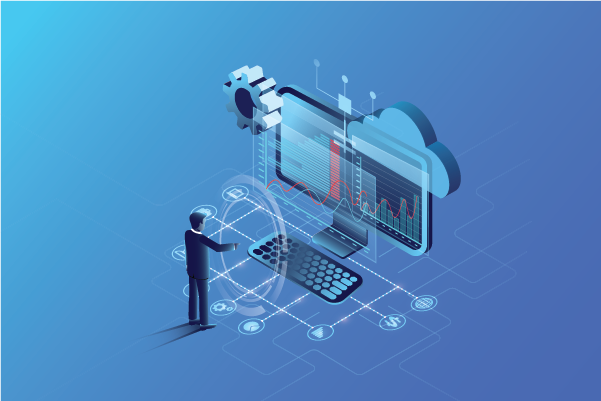What was initially considered to be an isolated incident quickly snowballed into a global pandemic, with far-reaching consequences? The IT industry has never been under so much pressure to deliver, as organizations were compelled to rethink and realign their work and business models according to the wants and needs of the remote engagement.
Organizations, now more than ever before, have to be increasingly agile in terms of digital transformation and move at the speed of light to meet heightened business requirements. As a key imperative of digital transformation, data, applications, systems, and devices spread across an organization have to connect to drive operational efficiencies and business outcomes.
APIs have proved to be the connective tissue that unifies different components of IT infrastructure. They are also instrumental in breaking down monolithic systems, and data silos, and creating new revenue streams for organizations. Here is a key statistic that establishes the relationship between APIs and digital transformation - according to the 2021 Connectivity Benchmark Report, 96% of the organizations currently use APIs, compared to 80% in 2020.
Successful API programs must consider developers and developer experience as their core constituents. Improving the developer experience will result in higher adoption, low integration costs, and enhanced agility.
API portals ensure that developers can discover and use your APIs, and it acts as a bridge that connects different stakeholders.
A good developer portal promotes community development, and collaboration between the API team and developer communities to enhance value for the entire API ecosystem.
What does an API developer portal do for you?
An API developer portal is a central repository for your APIs and provides information about the API to the developers. It is a website that enables you to publicize your APIs, educates developers' communities on how to use and access them, and much more.

As the internet widened the reach of businesses beyond geographical limitations, APIs allow businesses to expand their enterprise boundaries, drive revenue through new models, and leverage previously unexploited enterprise resources and data. The API is the cornerstone of this new business model, allowing organizations to share their data and resources with other enterprises. Developer portals act as a conduit between API providers and API consumers to facilitate the exchange of value.
Developers add functionality to existing applications or build new applications by using services from other API providers. While APIs accelerate app development, and innovation, and reduces the time to market, developer portals facilitate the use of APIs by developers with ease and simplicity.
An API portal helps developers register applications, interact with API documentation, provide feedback about the API, and report bugs. It provides functional documentation like API guides, status codes, and technical documentation that includes information about assembling resources and function calls.
What kind of value does a good API portal deliver?
Effective communication and user experience are the key components of a good API developer portal. A good portal should provide documentation on APIs to facilitate adoption and use by developers. The API documentation provides details about the API functionality, how to effectively use and integrate it, and updates on the API lifecycle such as new versions, uptime, or retirements.
The purpose of a good API portal is to:
- Aid discoverability: The meaning of API discovery depends on the context in which it is used. When external users are looking for APIs to augment the functionality of their application, they may use search engines or API listings to identify the relevant APIs. An optimized developer portal can make your APIs ‘discoverable’ by external users or developers. Additionally, a comprehensive search engine within the developer portal can help external and internal users refine their search and find the most relevant APIs.
- Create awareness: A developer portal helps to create awareness about API capabilities and their benefits to the developers and business users. A developer portal acts as a central repository for documentation and reference guides. This enables developers and business users to make informed decisions about the utility and applicability of APIs for their use cases.
- Enables software exploration: After an initial assessment and selection, developers would like to experiment by integrating APIs with their applications. A developer portal offers trial logins to allow developers to test APIs in a development or staging environment, often called a ‘sandbox’.
- Simplify onboarding: The developer portal helps developers overcome the challenges of adopting a new API with self-registration and a guided tour. The portal expedites decision-making for developers and users with easy-to-understand terms of services and cost estimation. The portal also facilitates developer communication with the API team for clarification on integration and technical issues, thus enabling quick adoption.
- Promote user engagement: A well-built developer portal facilitates collaboration between API teams and developer communities. The social features in the developer platforms encourage sharing of ideas that will help you to enhance and evolve APIs.
Best practices to build a developer-friendly API portal
- Intuitive UI/UX: Optimizing the developer experience on the portal is often neglected, and is a root cause for low adoption. You need to have a user-friendly intuitive interface for your developer portal. The developers have certain expectations of portal design and functionality based on industry standards, which you should incorporate for your portal.
- Shortened learning curve: Guides and Tutorials help to reduce the learning curve for developers and accelerate application development. The guide section on your developer portal describes the functionality, and benefits of APIs. The guide helps developers learn API basic concepts, and vocabulary. The information about API capabilities will help developers and business users evaluate whether or not an API will serve their requirements.
Tutorials provide detailed step-by-step instructions about various API resources and how they can be used. - API-use cases and case studies: Case studies provide insights to developers on the possible implementation of your APIs. It helps developers visualize possible API use cases for their organization. You can also highlight some of your partners' work to provide a broader scope of your API.
- API Reference: The API Reference section documents every endpoint. Your objective should be to represent client use of your API for multiple client technologies, and the most popular programming languages in use by web and native client developers.
- API Explorer: An API Explorer helps developers explore various APIs interactively. The live testing facilities enable developers to explore the solution directly, instead of relying on documentation only. This will lead to faster adoption of your APIs by developers.
- Documented error responses: As developers experiment with your API, there are bound to be errors. You can put a URL in the error response, which provides more context about the errors. Good error documentation helps developers to troubleshoot error response codes, and ease the burden on your developer support team.
- Multiple support channels: You can include a Frequently Asked Questions (FAQ) section, and an online channel for users to send queries. You can set up a community forum to enable your users to answer each other’s queries. You can either embed a chat solution in your developer portal or offer it through a communication platform; for example, Slack. This provides developers with almost instant access to the API team for resolving queries about integration and other technical issues.
- Changelog for up-to-date information: Changelog helps to keep developers updated on notable changes to your APIs, improvements, new endpoints, and other modifications that may have a material impact. Changelog acts as ‘release notes’ and will help developers find new ways to leverage your API.
- Self-service support hub: The developer portal helps developers discover APIs, manage API keys, create proxies for APIs, and much more. The portal should allow developers to accomplish tasks with minimal intervention or requiring permissions after they have been registered and authenticated.
- Status: The status page displays the operational status, like the uptime of your APIs. The page can also be used to display an incident history section with reviews of any previous downtimes. The public uptime monitoring section enhances developer confidence in the reliability and availability of your APIs.
Create API Developer Portals to drive API Adoption
Your portal should meet developer requirements at different stages of their API journey. A developer's journey can be classified into five stages; discover, evaluate, get started, develop/ troubleshoot, and maintain. You can frame the questions that encapsulate the developer requirements across all five stages of their API journey, and ensure that your portal provides answers to these questions.
You need to select the right developer portal for your business, with two popular choices being Apigee Integrated Portal and a DIY Custom Drupal Portal. You can find a comparative analysis of the two portals in our blog post, Decoding Developer Portals: Choosing the Right Option That Works for You.
As an API Management Services provider, Srijan can help you select the right developer portal for your business. Our UX expertise, technical know-how, and consultative approach can point you in the right direction to create a portal that meets the developer’s expectations and drives API adoption.
Our Services
Customer Experience Management
- Content Management
- Marketing Automation
- Mobile Application Development
- Drupal Support and Maintanence
Enterprise Modernization, Platforms & Cloud
- Modernization Strategy
- API Management & Developer Portals
- Hybrid Cloud & Cloud Native Platforms
- Site Reliability Engineering




